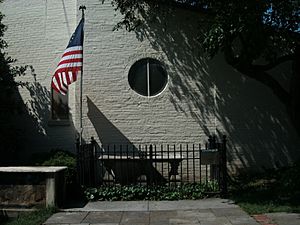Tomb of the Unknown Soldier of the American Revolution facts for kids
The Tomb of the Unknown Soldier of the American Revolution is a special place that honors a soldier from the American Revolutionary War. This soldier's name is not known. His remains were found in 1826 in Alexandria, Virginia. The memorial is in the churchyard of the Old Presbyterian Meeting House. This church has been around since 1772. You can find it in Alexandria's Old Town.
Contents
How the Memorial Was Created
Finding the Unknown Soldier
In 1826, workers were building a church next to the Old Presbyterian Meeting House. They found the body of a man. He was wearing a uniform from the Revolutionary War. No one knew who he was. The body was then reburied in the Meeting House churchyard.
A woman named Mary Gregory Powell (1847-1928) helped keep his memory alive. She was a member of the church. Her father, William Gregory, had served the church for many years. As a child, Mary used to place flowers on the soldier's unmarked grave.
A Time for Honoring Heroes
The 1920s was a time when many people wanted to honor soldiers. After World War I, many soldiers were still unidentified. Countries like Great Britain and France built memorials for their unknown soldiers in 1920. The United States dedicated its own memorial at Arlington National Cemetery in 1921. This inspired people to honor earlier heroes too.
People also became very interested in preserving America's history. The Presbyterian Meeting House itself was restored starting in 1925. As this project finished, Mary Gregory Powell suggested honoring the Unknown Soldier. The decision was made to mark his grave officially. The local American Legion Post No. 24 helped lead this effort.
First Marker Placed
On February 22, 1928, a temporary marker was placed at the grave. This happened during Alexandria's yearly celebration of George Washington's birthday. People gathered at Gadsby's Tavern. Then they walked through the city to the Meeting House. Mary Gregory Powell dedicated this first wooden marker.
Dedication of the Memorial
The Official Ceremony
The memorial you see today was created by the National Society of the Children of the American Revolution. Mrs. Josiah A. Van Orsdel, their president, led the project. The memorial was officially dedicated on April 19, 1929. This date is known as Lexington-Concord Day.
The ceremony took place inside the Presbyterian Meeting House. Mrs. Van Orsdel led the service. John B. Gordon shared the story of finding the grave. James W. Good, the U.S. Secretary of War, spoke about unknown soldiers. William Tyler Page, who wrote "The American's Creed," read a special poem. The U.S. Army Band played music. They joined the church's old organ to lead the singing of "The Star-Spangled Banner."
After the service, everyone moved to the gravesite. The church bell rang slowly. Many patriotic groups placed wreaths at the memorial. The whole event lasted 90 minutes. It was even broadcast live on the radio station WRC.
Epitaph
Here lies a soldier of the Revolution whose identity is known but to God. His was an idealism that recognized a Supreme Being, that planted religious liberty on our shores, that overthrew despotism, that established a people's government, that wrote a Constitution setting metes and bounds of delegated authority, that fixed a standard of value upon men above gold and lifted high the torch of civil liberty along the pathway of mankind. In ourselves his soul exists as part of ours, his memory's mansion.
The Memorial Today
The Tomb of the Unknown Soldier of the American Revolution is still honored often. Visitors come to see it. Many groups hold special ceremonies there. These groups include the Children of the American Revolution, Daughters of the American Revolution, Sons of the American Revolution, and Veterans of Foreign Wars.
Other Unknown Soldier Memorials
There are three other memorials for unknown soldiers of the American Revolution:
- One is in Washington Square, Philadelphia, Pennsylvania. It was created in 1957.
- Another is near Jamestown, Virginia. It was created in 2016.
- The third is at Fort Laurens in Bolivar, Ohio. This was the only Revolutionary War fort in Ohio.


